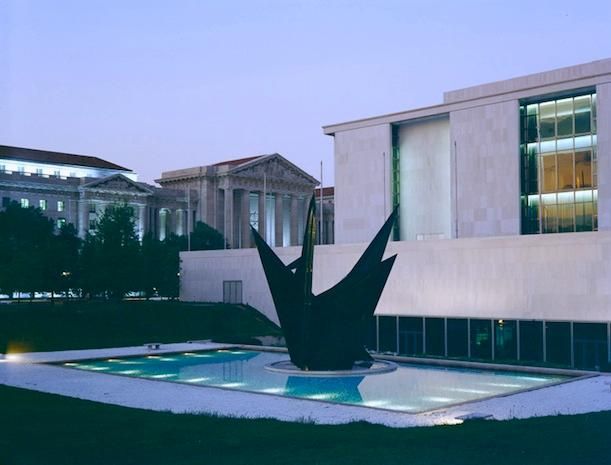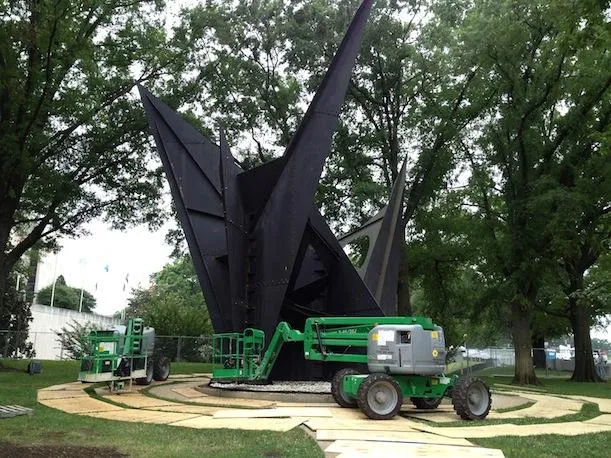How Do You Freshen Up an Alexander Calder? Bolt by Precious Bolt
Alexander Calder’s 40-foot black steel sculpture is getting a makeover and then returning to its original location near the American History Museum
/https://tf-cmsv2-smithsonianmag-media.s3.amazonaws.com/filer/20130711075040Proposed-Reinstallation-rendering-created-by-Ewing-Cole-architects-20111.jpg)
On June 2, 1969, Washington philanthropist and socialite Gwendolyn Cafritz stood with sculptor Alexander Calder in front of an audience on the west side of the Smithsonian Museum of History and Technology (now the American History Museum) for the dedication of Calder’s latest sculpture.
Calder presented his work in few words: “I call it the Caftolin.”
The 71-year-old artist’s voice did not carry over the sounds of an aircraft flying overhead, and the trucks and cars in the nearby street, so Cafritz had to repeat to the crowd what he had said. But she called the work instead by another name—one that Calder had originally considered—the “Gwenfritz.”
Both titles were a play on Cafritz’s first and last names, because she had commissioned the work and was donating it to the Smithsonian Institution.
Minutes later, S. Dillon Ripley, secretary of the Smithsonian at the time, announced what would become the official name. “Bravo to the Gwenfritz,” he said.
This wasn’t the only time Calder’s intentions were overlooked regarding his 40-foot black steel structure. The first was when he was still designing the piece in the surrounding landscape. He had envisioned the sculpture within a pool of fountains, but the project was downsized to a static pool. The other was in 1983 when the sculpture was unceremoniously moved from its original location on the museum’s west side to a spot on the corner of 14th Street and Constitution Avenue where it was placed in a grove of trees that soon grew to be taller than the sculpture’s highest point.
Calder fans were not pleased. “You couldn’t see it,” says historian James Goode, who criticized the move in a book about Washington sculptures. “It didn’t have the breathing space.”
Now, “Gwenfritz,” one of Washington, D.C.’s first modernist public sculptures, will not only be moved back to its original location, but it will get a thorough conservation treatment. This week, a conservation team will finish disassembling the structure, and the parts will be shipped to Manassas Park, Virginia, July 18 in a caravan of wide-load trucks. After the conservation treatment is complete, the newly painted pieces will be shipped back to the museum in October, to be reassembled and reinstalled.
One of the biggest differences between the 1969 debut of the sculpture, known as a stabile (the opposite of a mobile) and its current restoration is the shifting attitude toward abstract art. Karen Lemmey, a curator at the American Art Museum, which owns the sculpture, says “Gwenfritz” was one of those pieces that broke ground for abstract art in Washington D.C. “Gwenfritz” along with Jose de Rivera’s “Infinity” (also on view in the plaza in front of the American History Museum) possibly played a part in changing the city’s aesthetic and steering it away from its former “very predictable arts program,” Lemmey says. At the time, the city was dotted with public works depicting generals on horseback. Calder’s work was something entirely new.
“It speaks to a high point in the arts at that moment,” says Lemmey. The sculpture was originally made in France and shipped to the United States in pieces. The staff at the American Art Museum were involved in putting it together according to Calder’s instructions. “We are in some ways reliving that moment as an Institution . . . that intimacy between Calder and the Smithsonian,” Lemmey says.
The treatment that conservators have planned for it in many ways mirrors that intimacy. “It’s a very interesting time in the field of outdoor painted conservation because these objects that were built in the ‘60s and ‘70s are now hitting that 45 to 50-year mark, and they’re actually at a tipping point,” Abigail Mack, a member of the conservation team, says. “For many years, would just recoat it. You put a new coat of paint on it. But at this point the object needs structural work.”

Although often forgotten and unseen by museum-goers in its current location among the trees, “Gwenfritz” has been on the verge of a makeover for more than 20 years, says Catherine Perge, an assistant director for exhibitions and projects at the American History Museum. This year was the first time that the funding and the timing aligned, so Perge and the conservators began to make immediate plans for the move.
Although removing 1,270 rusty bolts and dismantling the 75-piece structure seems more harmful than restorative, the goal is to revitalize the sculpture and revive its former glory. The conservation team will accomplish this by taking every piece apart, clearing out the corrosion and repainting the surface. The paint will mimic Calder’s signature matt-black color, but the new paint, a result of a collaboration between the U.S. Army Research Lab and the National Gallery of Art, will last longer and help to prevent future corrosion.
“Gwenfritz” will be among the first recipients of the military-strength paint, but despite the advancement in technology over the last few decades, the conservation process is not meant to remake “Gwenfritz” into a stabile of the future.
“You can’t expect a paint to last for 45 years,” Mack says. “That’s something that the artist understood. For objects that are made by fabricators, painted by industrial painters, it’s understood that we’re going to be repainting it, so my goal is to conserve the artist’s intent, not the original paint.”
Mack, who has helped conserve more than 40 Calder sculptures in her career, calls this project a challenge. It’s the largest structure she’s ever worked with, and the pieces must be put back together in exactly the right way. The first piece taken off—the tip of one of the many points on the sculpture—alone weighed as much as the average car. Calder, who was trained in engineering, designed every bit of the sculpture himself, and one misplacement would change the aesthetic. To the conservation team, “Gwenfritz” is a giant jigsaw puzzle.
“They should see Alexander Calder when they look at this object,” Mack says. “They shouldn’t see my marks . . . .We’re just trying to preserve what the artist wanted.”
When the sculpture’s makeover is completed and the parts are put back together, it should appear as if nothing has changed. The steel points will shoot prominently toward the sky as before, and the jet black color will reflect clearly in the pool just the same. Not only will the metal parts be restored, but so will Calder’s intentions.
